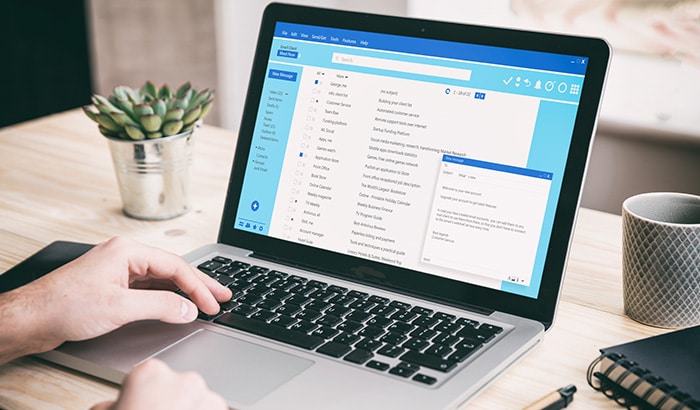We all know having an email list with many subscribers is good for business. But how often do we discuss what to do when unsubscribe rates are higher than usual? Whether you’re noticing a steady downward trend or a lot of unsubscribers all at once, you’re likely reading this blog because you need a little help.
This blog covers the importance of email lists, why high unsubscribe rates are bad, and seven possibilities as to why yours might be high. Following the tips outlined in this blog will help you retain your email subscribers and continue to grow a healthy email list!
The Importance of Email Lists
Having an email list matters for several reasons. It’s a direct line of communication with your audience that allows you to build relationships with them. Let’s take a closer look at why you should have an email list.
- Direct and Personal Communication: Email provides a direct, personal channel to communicate with your audience. Unlike social media platforms or search engine algorithms, email lets you reach your subscribers directly in their inboxes. This level of direct communication enables you to build a deeper and more personal connection with your audience.
- Targeted Marketing: With an email list, you can segment and target your audience based on demographics, interests, purchase history, or engagement levels. This targeted marketing approach allows you to deliver more relevant and personalized content to different audience segments, increasing the likelihood of engagement and conversion.
- Relationship Building: You can build trust and credibility with your audience by consistently delivering valuable and relevant content to your email subscribers. Over time, this relationship-building can lead to brand loyalty, repeat purchases, and customer advocacy.
- Engagement and Conversion: Email marketing has one of the highest engagement and conversion rates compared to other marketing channels. When you have an email list of engaged subscribers who have voluntarily opted in to receive your emails, you have a captive audience who is more likely to open, read, and take action on your emails.
- Ownership and Control: Unlike social media platforms or search engines, where algorithms and policies can change, your email list is a digital asset you own and control. This ownership allows you to communicate with your audience without solely relying on external platforms or algorithms.
- Cost-Effective: Email marketing is more cost-effective than many other channels. The cost of sending emails to your subscriber list is relatively low, especially compared to traditional marketing methods like direct mail or print advertising. This affordability makes email marketing accessible to businesses of all sizes.
- Measurable Results: Email marketing allows you to track and measure various metrics such as open rates, click-through rates, conversion rates, and more. These measurable results provide valuable insights into the effectiveness of your email campaigns, allowing you to make data-driven decisions and optimize your marketing efforts.
The Importance of Understanding Your Unsubscribe Rate
Understanding your unsubscribe rate is essential for the success of your email marketing campaigns.
Firstly, it provides insights into how well your content resonates with your audience. A high unsubscribe rate indicates that recipients aren’t finding value in your emails or that you are not meeting their expectations.
Keeping track of the unsubscribe rate lets you remain aware of the relevance of your content and identify areas where you can improve. A high unsubscribe rate also suggests an unhealthy email list; monitoring it allows you to take steps to improve its quality.
Secondly, high unsubscribe rates can negatively impact the deliverability of your emails. Email service providers evaluate unsubscribe rates to determine the reputation of senders.
If your unsubscribe rate is consistently high, it may raise red flags and result in your emails being labeled as spam or delivered to the recipient’s junk folders. By understanding your unsubscribe rate, you can proactively address any deliverability issues and maintain a positive email sender reputation.
Thirdly, unsubscribe rates provide valuable customer feedback and insights. By analyzing exit surveys and feedback forms from users who unsubscribe, you can understand what aspects of your content, frequency, or email experience may not be meeting expectations. Leveraging this feedback can improve your email strategies, enhance customer satisfaction and reduce future unsubscribe rates.
Subscriber acquisition is typically more costly than retention. So, by understanding and taking action to reduce your unsubscribe rate, you can improve your email marketing campaigns’ return on investment (ROI). Retaining loyal subscribers saves money and ensures a more engaged and responsive audience, increasing conversions and revenue generation potential.
Monitoring and analyzing your unsubscribe rate allows you to refine your strategies, improve customer satisfaction, strengthen your email marketing performance, and preserve a healthy email sender reputation.
Now that we’ve covered why your unsubscribe rate matters, let’s look at some possibilities for why your unsubscribe rate is so high. Implementing the changes recommended in the following section should help improve the overall effectiveness and quality of your email marketing.

7 Possibilities for Why Your Unsubscribe Rate Is So High
1. Mismatched Expectations:
Mismatched expectations can lead to high unsubscribe rates when what your email subscribers receive doesn’t align with what they expect to get from your emails. When sending emails, delivering what you’ve promised is essential. It’s preferable to exceed those promises to add even more value.
For example, you may have promised content with tips and advice on digital marketing, but your email copy is promotional. Your subscribers who expected to receive valuable content on digital marketing may not find this email useful, resulting in disappointment and subscription.
Another example is when you promised a few emails per month, but your subscribers receive emails every day. This could overwhelm the recipients, causing them to unsubscribe since they didn’t expect to receive multiple emails per day.
Moreover, sending emails too infrequently can also create mismatched expectations. For instance, when you promised to send weekly newsletters, but your subscribers only receive two to three emails a year, they may feel short-changed and unsubscribe.
2. Irrelevant or Low-Quality Content:
When subscribers receive content irrelevant to their interests or of poor quality, it can negatively impact their perception of the publisher, diminishing trust and the perceived value of the subscription. As a result, they may choose to unsubscribe.
For instance, subscribers might lose interest if they sign up to receive emails about gardening tips and tricks but consistently receive emails about technology or finance. This disconnect leads to dissatisfaction and an increased likelihood of unsubscribing.
Additionally, low-quality content lacking substance or value can frustrate subscribers. People subscribe to receive information, insights, or entertainment that meets their expectations. If the content they receive is subpar, contains errors, or lacks depth, it diminishes their experience and perceived value.
This disappointment can ultimately result in higher unsubscribe rates.
It’s important to consistently deliver relevant and high-quality content that aligns with the interests and expectations of your subscribers. Doing so can maintain engagement, build trust, and reduce the likelihood of unsubscribed.
3. Overly Frequent or Infrequent Emails:
Sending emails too frequently can overwhelm subscribers and lead to higher unsubscribe rates. When subscribers receive excessive emails from a sender, it can feel intrusive and disrupt their inbox organization. This can be especially true if the email content does not provide sufficient value or relevance to justify the frequency.
For example, imagine a subscriber who signs up for a weekly newsletter but starts receiving daily promotional emails. If those emails are not valuable or anticipated, the subscriber may feel bombarded with messages and decide to unsubscribe to regain control of their inbox and reduce the perceived clutter.
On the other hand, sending emails too infrequently can also lead to higher unsubscribe rates. When subscribers sign up for an email list, they expect regular communication. If they don’t receive emails as often as anticipated, they may question the value of remaining subscribed. Infrequent email communication can create a sense of disengagement and make subscribers forget about their initial interest in the content.
For instance, if a subscriber signed up expecting to receive weekly updates but only receives an email every few months, they may forget the context of their subscription and question whether it’s worth keeping. This lack of regular interaction can weaken the bond with subscribers and increase the likelihood of them unsubscribing.
Finding the right balance in email frequency is crucial. It’s important to set clear expectations regarding email frequency during sign-up and deliver consistent and valuable content accordingly. Understanding your audience’s preferences and engagement levels can help you strike a good balance that keeps subscribers engaged without overwhelming or neglecting them.
4. Poor Subscriber Experience:
A poor subscriber experience can significantly impact whether an individual decides to unsubscribe from your email list. When subscribers have a negative experience, it can erode their trust, decrease engagement, and ultimately lead them to unsubscribe.
Several factors can contribute to a poor subscriber experience, including irrelevant content, poor email design, overwhelming frequency, and a difficult unsubscribe process. We’ve already touched on some of these points, but let’s look at poor email design and a complex unsubscribe process, as these can be significant factors.
Poor Email Design
The design of your emails plays a crucial role in the subscriber experience. If your emails are difficult to read, cluttered, or have formatting issues, it can create a negative impression. Subscribers may perceive a lack of professionalism or regard for their experience, leading them to question the value of remaining subscribed.
Difficult Unsubscribe Process
If unsubscribing from your email list is cumbersome or challenging, it can leave a lasting negative impression. Subscribers could perceive this as an attempt to hold onto their information against their wishes, creating a sense of frustration and distrust. A poor unsubscribe experience can result in a direct and immediate decision to unsubscribe.
To ensure a positive subscriber experience, it’s important to deliver relevant content, design visually appealing and easy-to-read emails, respect subscriber preferences and frequency expectations, and simplify the unsubscribe process. By prioritizing the needs and preferences of your subscribers, you can enhance their experience, cultivate trust, and reduce the likelihood of them wanting to unsubscribe.

5. Subscription Fatigue: Subscription fatigue is a phenomenon where subscribers become overwhelmed with the number of emails they receive from numerous email lists. It’s common in today’s digital age, where people are flooded with information from various sources.
Here’s how this can increase the unsubscribe rates:
- Reduced Relevance: If subscribers receive too many emails, they may ignore most of them or just scan through them to catch up. This makes it difficult for publishers to deliver relevant content, leading to a decline in engagement and interest. They may eventually lose interest in the publisher’s content and decide to unsubscribe.
- Frustration and Disengagement: When people receive overwhelming emails, it can create frustration and feel intrusive. If subscribers perceive the emails they receive from a particular publisher to be irrelevant or too frequent, it can cause them to become disengaged and prompt them to unsubscribe. Even if the content is valuable, the frequency of emails can be a deciding factor for some subscribers.
- Negative Experience: Subscription fatigue can create a negative impression on the subscriber’s mind and tarnish their perception of the publisher. Negative experiences like this can impact the subscriber’s trust and confidence in the publisher, ultimately leading them to unsubscribe and potentially damage future opportunities to engage with the subscriber.
Managing email frequency carefully is essential to avoid subscription fatigue and reduce unsubscribe rates. Publishers should deliver valuable and relevant content that aligns with subscriber preferences while respecting their privacy and inbox space. The focus should be creating value-driven content that serves subscribers’ interests rather than bombarding them with too many emails.
6. Technical Issues: Technical issues can contribute to high unsubscribe rates. When subscribers experience persistent technical problems while interacting with an email program, it can lead to frustration and dissatisfaction, prompting them to unsubscribe. Here are a few ways technical issues can impact unsubscribe rates:
- Email Delivery Problems: If technical issues arise during the email delivery process, such as server errors, spam filtering mistakes, or blacklisting, it can result in subscribers not receiving important emails or having them flagged as spam.
When subscribers consistently miss out on valuable content due to delivery issues, they may question the reliability of the email program and decide to unsubscribe. - Broken Personalization or Dynamic Content: Many email programs use personalization and dynamic content to deliver customized messages to subscribers.
However, if technical issues disrupt these personalized elements’ accurate display or functioning, recipients may receive emails with incorrect or broken content. These issues can create confusion, diminish the user experience, and increase unsubscribe rates. - Unresponsive Design and Mobile Compatibility Issues: With most people accessing emails through mobile devices, emails must have a responsive design and be mobile-friendly.
If technical issues prevent emails from rendering correctly on mobile devices (think formatting problems or broken links), it can frustrate subscribers and create a negative user experience. This can lead to higher unsubscribe rates as users may perceive the emails as unprofessional or challenging to engage with. - Website or Landing Page Errors: Email campaigns often direct subscribers to a website or landing page for further information or conversions. If technical issues arise on the website or landing page, it can negatively impact the subscriber experience. Frustrated by a poor website experience, subscribers may lose trust in the brand or deem the emails ineffective and choose to unsubscribe.
To mitigate these technical issues and minimize unsubscribe rates, it is essential to regularly monitor email delivery, ensure proper personalization and dynamic content functionality, optimize emails for mobile devices, and conduct routine maintenance checks on websites and landing pages to avoid errors.
7. Inconsistency in Branding: When subscribers encounter inconsistent branding across emails or other communication channels, it can create confusion and decrease trust in the brand. This lack of coherence and reliability can lead to higher unsubscribe rates.
- Lack of Recognition and Trust: Consistent branding helps subscribers easily recognize and identify your brand. When there is inconsistency in the use of logos, colors, fonts, or tone of voice, it can confuse subscribers and make it difficult for them to connect and engage with your emails.
Subscribers may question the authenticity and reliability of the emails they receive from you, which can prompt them to unsubscribe. - Perception of Unprofessionalism: Inconsistent branding can give the impression of unprofessionalism or lack of attention to detail. When subscribers notice a lack of consistency in your emails’ visual elements, messaging, or overall presentation, it can create a negative perception of your brand.
This can make subscribers question the quality and value of your content, leading to higher unsubscribe rates as they seek more reliable and credible sources. - Confusion and Disengagement: Inconsistent branding can confuse subscribers. When there is a lack of coherence in the messaging or the overall brand experience, subscribers may struggle to understand your brand’s identity and purpose.
This confusion can result in disengagement and a decreased interest in receiving further emails from your brand, leading to higher unsubscribe rates. - Misalignment With Subscriber Expectations: Consistency in branding helps set clear expectations for subscribers. When there is inconsistency in the content or presentation of your emails, it can create a mismatch between what subscribers expect and what they actually receive.
This misalignment can disappoint subscribers and make them feel the emails no longer cater to their needs or interests. This, in turn, can increase the likelihood of them unsubscribing.
It’s crucial to establish and maintain a consistent brand identity across all communication channels to mitigate the impact of inconsistency in branding on unsubscribe rates. This includes using consistent visual elements, maintaining a coherent tone, and ensuring the messaging aligns with your brand values and purpose.
Maintaining a consistent and cohesive brand experience can enhance recognition, build trust, and reduce the likelihood of subscribers wanting to unsubscribe.
Leverage Your Email Marketing With Revity
Are you ready to take your email marketing to the next level and reduce unsubscribe rates? Look no further than Revity! Our team of experts is dedicated to helping businesses like yours optimize their email marketing strategies for success.
By partnering with Revity, you’ll gain access to valuable insights and industry best practices to help you effectively address the issues contributing to high unsubscribe rates. We understand the importance of consistent branding, technical proficiency, and engaging content, and we know how to implement these strategies to maximize your email marketing results.
Contact Revity today to schedule a consultation, and let us guide you on the path to email marketing success. Our team will work closely with you to understand your unique goals and challenges.
We’ll develop a customized plan to improve your email delivery, enhance your branding consistency and create engaging content that resonates with your subscribers. Don’t wait; get started today! Call us at 801.895.4034, or schedule an appointment with us through our website. Partner with Revity today!







